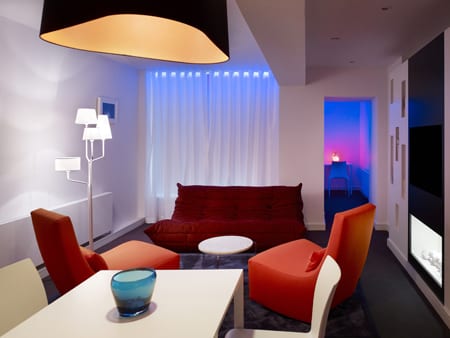Hospitality Design (HD) magazine and Culintro, a culinary trade organization in New York that brings together restaurant professionals, have teamed up to bring a monthly online Q&A with some of the nation’s top restaurant designers. Each month, we will feature a Q&A with an industry leader, talking about his/her newest project, the industry, what works, and what’s next.
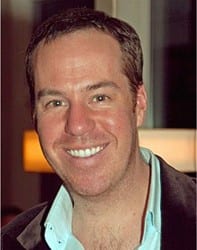 Griz Dwight
Griz Dwight
GrizForm Design Architects
Washington, DC
www.grizform.com
When he founded Grizform Design Architects in 2003, Griz Dwight set out to push creative boundaries. And, as energetic Washington, DC, restaurants like Estadio and PS 7 reveal, he’s succeeded. Here, Dwight, winner of the 2008 AIA|DC Emerging Architect Award, discusses growing up in an old barn, how physics has informed his design work, and why you’ll always hear music playing in his office.
HD: What are some of your first memories of design?
GD: When I was 7, we moved out of our apartment in Boston and into an old Vermont barn, which had been ‘renovated’ to be a house. The interior was over two stories tall and the entire post and beam structure was held together without nails or screws. I remember how great it felt to have a space with a history, and I remember terrifying my mother by climbing out on the beams to get a look of the living room from above.
HD: Did you always know you wanted to be a designer?
GD: No, not at all, but I don’t remember ever wanting to be anything realistic. Superhero was out of the question due to my lack of superpowers.
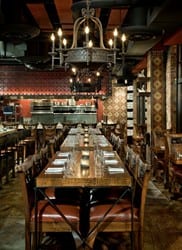 HD: How did you end up where you are today?
HD: How did you end up where you are today?
GD: My only male role models growing up were the men who my mother dated, so I spent a lot of time tagging along with the carpenter who built decks around town, the architect who had a house with one wall that folded down to become a deck, the sculptor who worked with found objects, and the photographer who developed film in the basement. There was always design in my life and many of the summer jobs of my youth involved swinging a hammer, pouring concrete, or welding.
For most of my time at Williams College, I was a double major in studio arts and physics. I know that it sounds strange to have two completely disparate majors but I loved the creativity that the studio offered me and I also needed the unambiguous answers that physics could provide. I remember sitting around the dorm one spring talking with someone whom I barely knew about what we were going to be ‘when we grew up.’ I had no idea but she was quite certain that I could not be anything other than an architect. I thought about it, and she was right. I applied to a few graduate schools with my art portfolio, got into the University of Pennsylvania, and never questioned it again.
HD: Talk to us about GrizForm Design Architects.
GD: I like to keep the firm small and creative and there is only one rule that I have about the office: there always has to be music playing. Anyone can play anything and everyone has veto power but silence is not allowed. Currently there are three of us and it’s important to me that we work collaboratively on our projects. I think that different perspectives on problems can inform decisions and together we can come up with better solutions than we could have come up with individually. I’ve considered growing the firm at various points but I am wary to do so because I love being a designer. I want to get my hands dirty and I like answering the phone and talking to clients and vendors. My concern is that I would only be a manager if the firm was too large.
 HD: Why DC?
HD: Why DC?
GD: DC has been has been a great place to survive for the past few years because our local economy is somewhat isolated from the problems that we are having nationally. Our tourism industry has remained strong and the lobbyists are still going out on their expense accounts. But don’t get me started on politics.
HD: Why did you want to start your own firm?
GD: I had some previous jobs where I felt that the senior people were not open to alternate ideas or different ways of looking at things. I wanted to start a firm where collaboration could take place. I still keep my veto power but the team at GFD often brings great ‘outside of the box’ ideas.
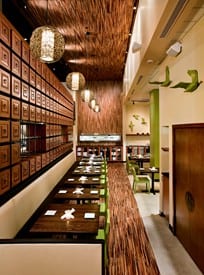 HD: What do you love about designing restaurants?
HD: What do you love about designing restaurants?
GD: I like that the success of a restaurant can be closely linked to its design. I think that it goes back to the art/physics of my undergraduate life; restaurants need to be beautiful but they also need to function. An ugly restaurant will fail just as fast as a beautiful yet inefficient one. Restaurant design allows you to push your creativity, and I have been able to convince my clients to step out of their design comfort zone. When you design someone’s house they say ‘thank you’ and close the front door, but when you design a restaurant, the client says, ‘Thanks, and have a seat.’ I love being able to go back to the spaces that we have designed and experience them over and over. One of the biggest kicks that I get is sitting at the bar on opening night and watching people as they come in for the first time.
HD: Hate to use the word trend, but what trends are you paying attention to?
GD: I hate the word, too, but there seems to be a nostalgic bent to current design; I see a lot of designs that are reminiscent of the past or of an entirely different place altogether.
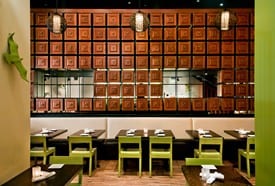 HD: What are the greatest challenges about designing restaurants?
HD: What are the greatest challenges about designing restaurants?
GD: Maintaining the balance between function and fashion. A restaurant is truly a machine and the successful ones need to operate on multiple levels. On any given day, I am talking about everything from mise en place, double rubs on fabric, and specialty gins to return on investments, turning tables, and average check sizes. To be successful, you have to know a lot of things about a lot of things.
HD: The industry has a lot of ups and downs. How have you remained successful?
GD: I think that we have been successful because we are turning out a great product in a previously underserved market. DC’s restaurant scene has been growing over the past 10 years and we were able to have some early successes, which propelled us to where we are today. You may not get many chances so it’s important to make the most of the ones that you get. Our overhead is also low so we have not had to cut back as much as some of our competitors have.
 HD: Talk to us about one of your latest restaurant projects.
HD: Talk to us about one of your latest restaurant projects.
GD: We recently completed Fiola Restaurant in DC, and we knew that we were in for a challenge when our clients chose a cursed space. The location had housed five different restaurant concepts in the past 10 years, with the space sitting vacant the last two of those years. Even more challenging was the fact that four of the five unsuccessful restaurants were Italian in concept, the same type of cooking that our clients planned on serving. In short, they chose a restaurant graveyard and a good portion of our budget needed to go towards an exorcism.
Layer upon layer was removed during demo. Removal of the wood floor from the French place that lasted six months revealed the Saltillo tile from one of the Italian concepts, removal of that led to carpet remnants, and so it went until the space was clean. With the building’s bones revealed, the problems of the space became clear. It was constructed with three slightly different floor levels and each previous restaurant had accentuated this by closing off each level from the others. Thus, the previous designs were a series of individual boxes, which shut down views, caused service problems, and generally made the space unpleasant to be in.
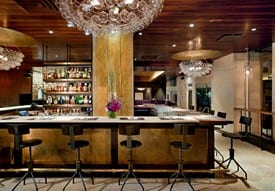 The solution was quite simple. We placed the bar on the highest level and set it up as a ‘see and be seen’ platform. The lowest portion was built up to create a dining room on one level. Now, the energy of the bar can flow into the dining room and there are no more awkward level changes.
The solution was quite simple. We placed the bar on the highest level and set it up as a ‘see and be seen’ platform. The lowest portion was built up to create a dining room on one level. Now, the energy of the bar can flow into the dining room and there are no more awkward level changes.
We chose to work the finish selections around chef Trabocchi’s menu, which balances both rustic and luxurious Italian ingredients. Golden onyx mosaic floors, spiral glass chandeliers, and glossy rosewood walls and ceilings evoke the grandeur of an Italian villa while the bar’s distressed copper panels, live-edge wood drink rails, leafy glass columns, and stone walls with arched views to the kitchen speak of the Italian landscape. Together these elements create a dining experience, which ties to the menu’s comfortable opulence.
HD: What has been one of your most rewarding projects and why?
GD: I’ve done two projects with Mark Kuller (Proof and Estadio) and we shared a similar vision for both from the beginning. Mark bought into what we were trying to do with the designs but he thoughtfully challenged our decisions. It was not enough to choose something because we liked it; we needed to justify it in relation to the overall direction. This made us pause and really evaluate the ‘why’ and it made a much better product. The lessons learned from working with Mark have improved all of our projects.
HD: What’s the most important thing to remember when you design a restaurant?
GD: The diner’s perspective. I try to mentally put myself in every seat of the restaurant as we are designing it-what does this person see, is it too loud, too bright, are they part of the action or removed from it. It’s easy to make things look cool for no reason but it is hard to design with discipline and direction.
HD: What’s one restaurant you love for its food?
GD: I’ve had many wonderful four-star meals but the ones that stand out are the unexpected ones. There is something special about stumbling upon a place that is off the beaten path.
HD: What’s a restaurant you love for its design (which you didn’t design)?
GD: I love AvroKO’s Public. I applaud them for taking a concept and designing a restaurant around it while maintaining the integrity of the original idea. They held true from the macro to the micro and the theme is consistent throughout. That’s not an easy thing to do.
HD: What’s next for you?
GD: We have projects in various stages of design in the DC area, Florida, and Brooklyn.
HD: What’s your dream job?
GD: Vegas. In general, diners on the Strip are willing to suspend their disbelief a little more than they would at their neighborhood joint. I would like to push the boundaries a little more than we have in the past. I would also love to get into hotel work. The translation between the restaurant design and other hospitality outlets would be a seamless one.
HD: Greatest lesson learned?
GD: Fight for what you believe in and make the most of every opportunity no matter how small.
HD: What was your last interesting work trip?
GD: I recently visited Naples, Florida, to check in on a project that we are designing there. My client and I were eating dinner and discussing the best bottle of wine that we had ever had. Mine was a Valdicava Brunello that my wife and I shared in a rundown restaurant in Florence. I lamented the fact that we have been unable to find the bottle again anywhere. Without warning, my client got up from the table and returned with two wine glasses and the exact bottle that I was talking about. Amazing.
HD: If you are not in the office, you are…
GD: Spending time with my wife and children (2 and 4 years old) or building something in my workshop.
HD: Motto to live by?
GD: If it ain’t broke, don’t fix it.
Pictured from top left: Griz Dwight: Estadio (two photos); Mandu (two photos); Fiola Restaurant (two photos)

